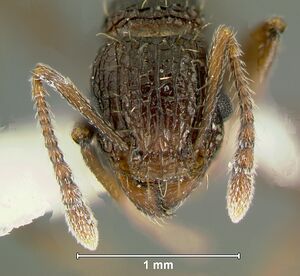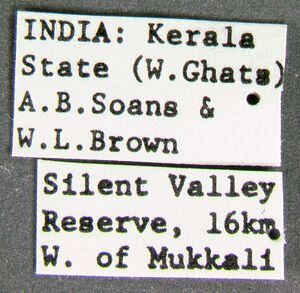Tetramorium tortuosum
| Tetramorium tortuosum | |
|---|---|

| |
| Scientific classification | |
| Kingdom: | Animalia |
| Phylum: | Arthropoda |
| Class: | Insecta |
| Order: | Hymenoptera |
| Family: | Formicidae |
| Subfamily: | Myrmicinae |
| Tribe: | Crematogastrini |
| Genus: | Tetramorium |
| Species group: | tortuosum |
| Species: | T. tortuosum |
| Binomial name | |
| Tetramorium tortuosum Roger, 1863 | |
| Synonyms | |
| |
A Sri Lanka specimen was found under a stone.
Identification
Bolton (1977) - This species is close to Tetramorium yerburyi and Tetramorium pilosum; its distinction from those species is discussed under yerburyi.
Keys including this Species
- Key to Afrotropical Tetramorium species groups
- Key to Tetramorium of India
- Key to the Indian and Sri Lankan Tetramorium tortuosum group species
Distribution
Akbar et al. (2023) - Tetramorium tortuosum is alleged to have a broad distribution range in the Indomalayan region, encompassing different parts of India, Indonesia, the Philippines and Sri Lanka.
Latitudinal Distribution Pattern
Latitudinal Range: 13.083889° to 6.916667°.
| North Temperate |
North Subtropical |
Tropical | South Subtropical |
South Temperate |
- Source: AntMaps
Distribution based on Regional Taxon Lists
Indo-Australian Region: Philippines.
Oriental Region: India, Sri Lanka (type locality).
Distribution based on AntMaps
Distribution based on AntWeb specimens
Check data from AntWeb
Countries Occupied
| Number of countries occupied by this species based on AntWiki Regional Taxon Lists. In general, fewer countries occupied indicates a narrower range, while more countries indicates a more widespread species. |

|
Estimated Abundance
| Relative abundance based on number of AntMaps records per species (this species within the purple bar). Fewer records (to the left) indicates a less abundant/encountered species while more records (to the right) indicates more abundant/encountered species. |

|
Biology
Association with Other Organisms
 Explore: Show all Associate data or Search these data. See also a list of all data tables or learn how data is managed.
Explore: Show all Associate data or Search these data. See also a list of all data tables or learn how data is managed.
- This species is a host for the cestode Raillietina echinobothrida (a parasitoid) (Quevillon, 2018) (encounter mode secondary; indirect transmission; transmission outside nest).
- This species is a host for the cestode Raillietina tetragona (a parasitoid) (Quevillon, 2018) (encounter mode secondary; indirect transmission; transmission outside nest).
Castes
Worker
   
| |
| . | Owned by Museum of Comparative Zoology. |
Nomenclature
The following information is derived from Barry Bolton's Online Catalogue of the Ants of the World.
- tortuosum. Tetramorium tortuosum Roger, 1863a: 181 (w.q.) SRI LANKA. Senior synonym of bellii, ethica: Bolton, 1977: 83.
- bellii. Tetramorium (Xiphomyrmex) tortuosum var. bellii Forel, 1902c: 239 (w.) INDIA. Junior synonym of tortuosum: Bolton, 1977: 83.
- ethica. Tetramorium (Xiphomyrmex) tortuosum var. ethica Forel, 1911i: 225 (w.) SRI LANKA. Junior synonym of tortuosum: Bolton, 1977: 83.
Unless otherwise noted the text for the remainder of this section is reported from the publication that includes the original description.
Description
Worker
Bolton (1977) - TL 3.8-4.4, HL 0.82-0.92, HW 0.78-0.86, CI 89-95, SL 0.70-0.80, SI 89-97, PW 0.60-0.70, AL 1.12-1.20 (15 measured).
Mandibles striate. Antennal sea pes moderately long, with SI approaching 100 but apparently always with HW> SL. Frontal carinae long, reaching back almost or quite to the occipital margin, the latter broadly and very shallowly concave. Antennal scrobes shallow and feeble impressions, shorter than the scape and not capable of containing it. Pronotal corners in dorsal view with rounded angles. Propodeal spines strong and acute, the metapleural teeth acute and generally triangular, but narrow in some specimens. Node of petiole in profile longer than high, the dorsal surface feebly convex and meeting the anterior face in a blunt but distinct angle. Post petiole rounded, convex above. In dorsal view the petiole node slightly longer than broad, the postpetiole subglobular and somewhat broader than long. Dorsum of head firmly and predominantly longitudinally rugulose but with a tendency to form narrow and feeble cross-meshes, especially posteriorly. The rugulae themselves are narrow, low and rounded. Dorsal alitrunk with similar but even more feeble rugulation, in places the rugulae tending to be effaced and replaced by shining areas. Sides of petiole usually retaining faint traces of sculpture but the dorsum generally smooth, only rarely with vestiges of sculpture. Postpetiole and gaster unsculptured. Hairs on dorsal head and alitrunk variable in length, usually shorter and stouter in Sri Lankan populations than in examples from India.
Type Material
Bolton (1977) - Syntype worker, female, Sri Lanka (H. Nietner) (location of types not known).
References
- Agavekar, G.; Hita Garcia, F.; Economo, E.P. 2017. Taxonomic overview of the hyperdiverse ant genus Tetramorium Mayr (Hymenoptera, Formicidae) in India with descriptions and X-ray microtomography of two new species from the Andaman Islands. PeerJ 5:e3800. (doi:10.7717/peerj.3800).
- Akbar, S. A.; Schifani, E.; Bharti, H.; Wachkoo, A. A. 2023. Taxonomic overview of the Tetramorium tortuosum group (Hymenoptera, Formicidae) in India and Sri Lanka, with descriptions of three new species from the Western Ghats biodiversity hotspot. Annales Zoologici Fennici 60:109-126. (doi:10.5735/086.060.0112).
- Baltazar, C.R. 1966. A catalogue of Philippine Hymenoptera (with a bibliography, 1758-1963). Pacific Insects Monographs 8: 1-488. (page 262, listed)
- Basu, P. 1997. Seasonal and spatial patterns in ground foraging ants in a rain forest in the Western Ghats, India. Biotropica 29: 489-500.
- Bharti, H. & Kumar, R. 2012. Taxonomic studies on genus Tetramorium Mayr (Hymenoptera, Formicidae) with report of two new species and three new records including a tramp species from India with a revised key. ZooKeys. 207:11-35. doi:10.3897/zookeys.207.3040
- Bolton, B. 1977. The ant tribe Tetramoriini (Hymenoptera: Formicidae). The genus Tetramorium Mayr in the Oriental and Indo-Australian regions, and in Australia. Bulletin of the British Museum (Natural History). Entomology. 36:67-151. (page 83, Senior synonym of bellii and ethica)
- Dias, R.K.S., Kosgamage, K.R.K.A. 2013. Occurrence and species diversity of ground-dwelling worker ants (Family: Formicidae) in selected lands in the dry zone of Sri Lanka. Journal of Science of the University of Kelaniya Sri Lanka 7: 55-72 (doi:10.4038/josuk.v7i0.6233).
- Dias, R.K.S., Rajapaksa, R.P.K.C. 2017. Geographic records of subfamilies, genera and species of ants (Hymenoptera: Formicidae) in the four climatic zones of Sri Lanka: A review. Journal of Science of the University of Kelaniya Sri Lanka 11, 23-45. (doi:10.4038/josuk.v11i2.7999).
- Roger, J. 1863a. Die neu aufgeführten Gattungen und Arten meines Formiciden-Verzeichnisses nebst Ergänzung einiger früher gegebenen Beschreibungen. Berl. Entomol. Z. 7: 131-214 (page 181, worker, queen described)
References based on Global Ant Biodiversity Informatics
- Basu P. 1994. Ecology of ground foraging ants in a tropical evergreen forest in Western Ghats, India. PhD Thesis, School of ecology and environmental sciences, Pondichery University, India. 155 pages.
- Bolton B. 1977. The ant tribe Tetramoriini (Hymenoptera: Formicidae). The genus Tetramorium Mayr in the Oriental and Indo-Australian regions, and in Australia. Bulletin of the British Museum (Natural History). Entomology 36:67-151.
- Bolton, B. "The ant tribe Tetramoriini (Hymenoptera: Formicinae. The genus Tetramorium Mayr in the Oriental and Indo-Australian regions and in Australia." Bulletin of the British Museum (National History): Entomology series 36, no. 2 (1977): 68-151.
- Chapman, J. W., and Capco, S. R. 1951. Check list of the ants (Hymenoptera: Formicidae) of Asia. Monogr. Inst. Sci. Technol. Manila 1: 1-327
- Dias R. K. S. 2002. Current knowledge on ants of Sri Lanka. ANeT Newsletter 4: 17- 21.
- Dias R. K. S. 2006. Current taxonomic status of ants (Hymenoptera: Formicidae) in Sri Lanka. The Fauna of Sri Lanka: 43-52. Bambaradeniya, C.N.B. (Editor), 2006. Fauna of Sri Lanka: Status of Taxonomy, Research and Conservation. The World Conservation Union, Colombo, Sri Lanka & Government of Sri Lanka. viii + 308pp.
- Dias R. K. S. 2013. Diversity and importance of soil-dweeling ants. Proceedings of the National Symposium on Soil Biodiversity, chapt 4, pp 19-22.
- Dias R. K. S., K. R. K. A. Kosgamage, and H. A. W. S. Peiris. 2012. The Taxonomy and Conservation Status of Ants (Order: Hymenoptera, Family: Formicidae) in Sri Lanka. In: The National Red List 2012 of Sri Lanka; Conservation Status of the Fauna and Flora. Weerakoon, D.K. & S. Wijesundara Eds., Ministry of Environment, Colombo, Sri Lanka. p11-19.
- Dias R. K. S., and K. R. K. Anuradha Kosgamage. 2012. Occurrence and species diversity of ground-dwelling worker ants (Family: Formicidae) in selected lands in the dry zone of Sri Lanka. J. Sci. Univ. Kelaniya 7: 55-72.
- Dias R. K. S., and R. P. K. C. Rajapaksa. 2016. Geographic records of subfamilies, genera and species of ants (Hymenoptera: Formicidae) in the four climatic zones of Sri Lanka: a review. J. Sci. Univ. Kelaniya 11(2): 23-45.
- Emery C. 1893. Voyage de M. E. Simon à l'île de Ceylan (janvier-février 1892). Formicides. Annales de la Société Entomologique de France 62: 239-258.
- Forel A. 1903. Les Formicides de l'Empire des Indes et de Ceylan. Part X. J. Bombay Nat. Hist. Soc. 14: 679-715.
- Forel A. 1904. Fourmis du Musée de Bruxelles. Ann. Soc. Entomol. Belg. 48: 168-177.
- Forel A. 1911. Ameisen aus Ceylon, gesammelt von Prof. K. Escherich (einige von Prof. E. Bugnion). Pp. 215-228 in: Escherich, K. Termitenleben auf Ceylon. Jena: Gustav Fischer, xxxii + 262 pp.
- Forel A. 1913k. Wissenschaftliche Ergebnisse einer Forschungsreise nach Ostindien ausgeführt im Auftrage der Kgl. Preuss. Akademie der Wissenschaften zu Berlin von H. v. Buttel-Reepen. II. Ameisen aus Sumatra, Java, Malacca und Ceylon. Gesammelt von Herrn Prof. Dr. v. Buttel-Reepen in den Jahren 1911-1912. Zoologische Jahrbücher. Abteilung für Systematik, Geographie und Biologie der Tiere 36:1-148.
- General D. M., and G. D. Alpert. 2012. A synoptic review of the ant genera (Hymenoptera, Formicidae) of the Philippines. Zookeys 200: 1-111.
- Mathew R., and R. N. Tiwari. 2000. Insecta: Hymenoptera: Formicidae. Pp. 251-409 in: Director; Zoological Survey of India (ed.) 2000. Fauna of of Meghalaya. Part 7. [State Fauna Series 4.] Insecta 2000. Calcutta: Zoological Survey of India, 621 pp.
- Tak N., and S. I. Kazmi. 2013. On some ants (Insecta: Hymenoptera: Formicidae) from Nagaland, India. Rec. zool. Surv. India: 113(1): 169-182.
- Tiwari R. N., B. G. Kundu, S. Roy Chowdhury, and S. N. Ghosh. 2003. Insecta: Hymenoptera: Formicidae. Fauna of Sikkim. Part 4. State Fauna Series. 9.Zool.Surv.India. i-iii, 1-512. Chapter pagination: 467-506.


